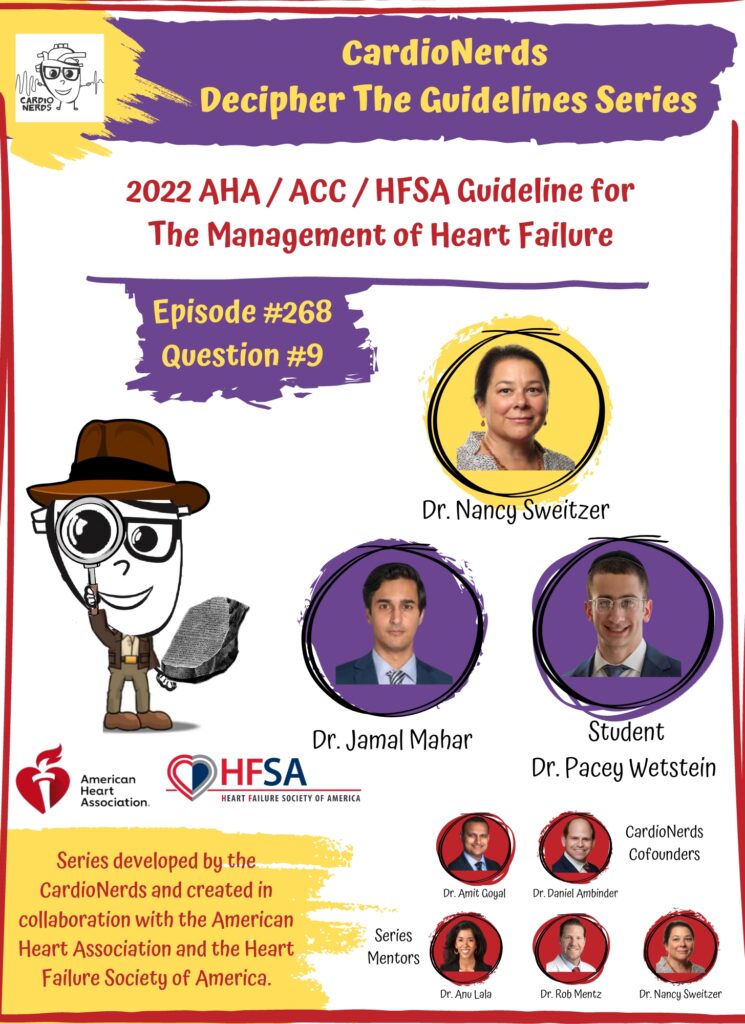Cardionerds: A Cardiology Podcast

268. Guidelines: 2022 AHA/ACC/HFSA Guideline for the Management of Heart Failure – Question #9 with Dr. Nancy Sweitzer
The following question refers to Section 7.6 of the 2022 AHA/ACC/HFSA Guideline for the Management of Heart Failure.
The question is asked by premedical student and CardioNerds Intern Pacey Wetstein, answered first by Baylor College of Medicine Cardiology Fellow and CardioNerds Ambassador Dr. Jamal Mahar, and then by expert faculty Dr. Nancy Sweitzer.
Dr. Sweitzer is Professor of Medicine, Vice Chair of Clinical Research for the Department of Medicine, and Director of Clinical Research for the Division of Cardiology at Washington University School of Medicine. She is the editor-in-chief of Circulation: Heart Failure. Dr. Sweitzer is a faculty mentor for this Decipher the HF Guidelines series.
The Decipher the Guidelines: 2022 AHA / ACC / HFSA Guideline for The Management of Heart Failure series was developed by the CardioNerds and created in collaboration with the American Heart Association and the Heart Failure Society of America. It was created by 30 trainees spanning college through advanced fellowship under the leadership of CardioNerds Cofounders Dr. Amit Goyal and Dr. Dan Ambinder, with mentorship from Dr. Anu Lala, Dr. Robert Mentz, and Dr. Nancy Sweitzer. We thank Dr. Judy Bezanson and Dr. Elliott Antman for tremendous guidance.
Mr. Flo Zin is a 64-year-old man who comes to discuss persistent lower extremity edema and dyspnea with mild exertion. He takes amlodipine for hypertension but has no other known comorbidities. In the clinic, his heart rate is 52 bpm and blood pressure is 120/70 mmHg. Physical exam reveals mildly elevated jugular venous pulsations and 1+ bilateral lower extremity edema. Labs show an unremarkable CBC, normal renal function and electrolytes, a Hb A1c of 6.1%, and an NT-proBNP of 750 (no prior baseline available). On echocardiogram, his LVEF is 44% and nuclear stress testing was negative for inducible ischemia. What is the best next step in management?
A
Add furosemide BID and daily metolazone
B
Start empagliflozin and furosemide as needed
C
Start metoprolol succinate
D
No change to medical therapy
Explanation
The correct answer is B – start empagliflozin and furosemide as needed.
The patient described here has heart failure with mildly reduced EF (HFmrEF), given LVEF in the range of 41-49%.
In patients with HF who have fluid retention, diuretics are recommended to relieve congestion, improve symptoms, and prevent worsening HF (Class 1, LOE B-NR). For patients with HF and congestive symptoms, addition of a thiazide (eg, metolazone) to treatment with a loop diuretic should be reserved for patients who do not respond to moderate or high-dose loop diuretics to minimize electrolyte abnormalities (Class 1, LOE B-NR). Therefore, option A is not correct as he is only mildly congested on examination, and likely would not require such aggressive decongestive therapy, particularly with normal renal function. Adding a thiazide diuretic without first optimizing loop diuretic dosing would be premature.
The EMPEROR-Preserved trial showed a significant benefit of the SGLT2i, empagliflozin, in patients with symptomatic HF, with LVEF >40% and elevated natriuretic peptides. The 21% reduction in the primary composite endpoint of time to HF hospitalization or cardiovascular death was driven mostly by a significant 29% reduction in time to HF hospitalization, with no benefit on all-cause mortality. Empagliflozin also resulted in a significant reduction in total HF hospitalizations, decrease in the slope of the eGFR decline, and a modest improvement in QOL at 52 weeks. Of note, the benefit was similar irrespective of the presence or absence of diabetes at baseline. In a subgroup of 1983 patients with LVEF 41% to 49% in EMPEROR-Preserved, empagliflozin, an SGLT2i, reduced the risk of the primary composite endpoint of cardiovascular death or hospitalization for HF. Therefore, in patients with HFmrEF, SGLT2i can be beneficial in decreasing HF hospitalizations and cardiovascular mortality (Class 2a, LOE B-R). Furthermore, by inhibiting glucose reabsorption in the kidney, they have a diuretic effect which may help ease congestion and limit loop diuretic dosing. SGLT2i are beneficial to the vast majority of cardiovascular patients but are contraindicated in patients with type 1 diabetes or prior episodes of diabetic ketoacidosis as they may cause euglycemic DKA.
Option C is incorrect. Among patients with current or previous symptomatic HFmrEF (LVEF, 41%–49%), use of evidence-based beta blockers for HFrEF, ARNi, ACEi, or ARB, and MRAs may be considered to reduce the risk of HF hospitalization and cardiovascular mortality, particularly among patients with LVEF on the lower end of this spectrum (Class 2b, LOE B-NR). However, the patient’s heart rate is already low and so initiating a beta blocker would be inappropriate. Switching his calcium channel blocker to ARNi may be considered.
Option D is not correct as we can help counsel him on lifestyle and medication changes which can relieve his symptoms and reduce his risk of HF hospitalizations and mortality.
Main Takeaway
In patients with HFmrEF, diuretics are useful for decongestion and symptomatic improvement (Class 1) and there is a role for GDMT including SGLT2i (Class 2a) and BB, ARNI, ACEi/ARB, MRA (Class 2b).
Guideline Loc.
Section 7.6.1, Figure 11
Decipher the Guidelines: 2022 Heart Failure Guidelines Page
CardioNerds Episode Page
CardioNerds Academy
Cardionerds Healy Honor Roll
CardioNerds Journal Club
Subscribe to The Heartbeat Newsletter!
Check out CardioNerds SWAG!
Become a CardioNerds Patron!







 Visit Podcast Website
Visit Podcast Website RSS Podcast Feed
RSS Podcast Feed Subscribe
Subscribe
 Add to MyCast
Add to MyCast